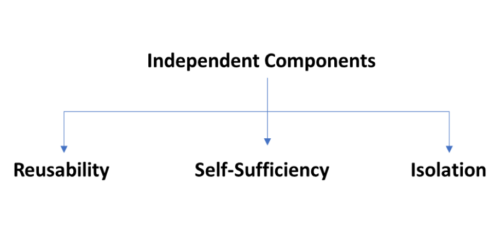Introduction:
Salesforce offers a robust platform for building and customizing applications to meet various business needs. As part of Salesforce development, components play a crucial role in designing and implementing the user interface and functionality. When working with components, it’s important to understand the concepts of independent and dependent components. In this blog, we will explore the differences between independent and dependent components in Salesforce and provide examples to illustrate their usage and benefits.
-
Independent Components:
Independent components in Salesforce are self-contained and do not rely on other components for their functionality. These components can function autonomously and can be reused across multiple applications or within different contexts. Key characteristics of independent components include:

- Self-Sufficiency: Independent components have their own logic, data handling, and user interface elements. They don’t rely on external components or data sources to operate.
- Reusability: Independent components are designed to be reusable, allowing developers to leverage their functionality in various parts of an application or even across different applications.
- Isolation: Independent components maintain their own state and do not depend on the state or behavior of other components. They operate independently and can be easily maintained and tested.
Example:
Let’s consider a scenario where you are developing a Salesforce application to manage events. Here are a few examples of independent components that can be utilized in this context:
-
Upcoming List of Events Component:
The “Upcoming List of Events” component displays a list of upcoming events. It fetches the event data directly from Salesforce using SOQL queries or an Apex controller. The component has its own logic to filter and sort the events based on criteria such as date, location, or type. It also handles user interactions like clicking on an event to view more details. This component can be used on various pages within the application, such as a dashboard, home page, or event management page.
-
Event Registration Component:
The “Event Registration” component provides a form for users to register for an event. It captures user input, such as name, email, and contact information, and submits the registration data to Salesforce to create a new registration record. This component has its own validation logic to ensure the entered data is accurate. It can be reused across different event detail pages or even on a custom community portal.
These independent components offer distinct functionalities and can be reused across different parts of the application. By designing independent components, you create modular and reusable building blocks that enhance development efficiency, maintainability, and flexibility in your Salesforce application.
-
Dependent Components:
Dependent components in Salesforce rely on other components or data sources to fulfill their functionality. They interact with their parent or surrounding components to access and manipulate data or to trigger specific actions. Key characteristics of dependent components include:

- Data Dependency: Dependent components require data from their parent or surrounding components to perform their intended functionality. They rely on data passed down to them through attributes or properties.
- Interaction: Dependent components often interact with their parent components or trigger events that invoke actions in the parent or other related components.
- Contextual Behavior: Dependent components adapt their behavior based on the context in which they are used. They utilize the data and behavior of their parent or surrounding components to provide specific functionality.
Example:
Let’s continue with the scenario of developing a Salesforce application to manage events. Here are a few examples of dependent components that rely on their parent or surrounding components for data and functionality:
-
Speaker List Component:
The “Speaker List” component lists the speakers associated with an event. It depends on the parent component, such as the “Event Details” component, to provide the event’s data, including the speaker’s information. The component receives the speaker data through attributes or properties and renders it in a formatted manner, including the speaker’s name, bio, and profile picture. It can also trigger events or actions in the parent component, such as opening a speaker’s profile or initiating communication.
-
Registration Status Component:
The “Registration Status” component shows the registration status for a particular event. It relies on the parent component, like the “Event Details” component, to pass the event data and the user’s registration information. Based on the received data, the component dynamically displays whether the user is registered for the event or not, along with additional details like registration date and payment status. It may also trigger actions in the parent component, such as allowing the user to modify their registration details.
These dependent components rely on their parent or surrounding components to provide necessary data and trigger specific actions. They enhance the functionality and interactivity of the application by utilizing the data and behavior of their parent or surrounding components. By designing dependent components, you can create cohesive and interconnected elements within your Salesforce application, enabling seamless collaboration and a more intuitive user experience.
-
Benefits and Considerations:
Understanding the distinction between independent and dependent components is crucial for effective Salesforce development. Here are some benefits and considerations for each type:
Independent Components:
- Improved Reusability: Independent components can be reused across different applications or contexts, reducing development effort.
- Enhanced Maintenance: Independent components are self-contained, making them easier to maintain, test, and update.
- Isolated Functionality: Independent components offer greater control and flexibility as they are not impacted by changes in other components.
Dependent Components:
- Contextual Adaptability: Dependent components can adapt their behavior based on the data and behavior of their parent or surrounding components.
- Component Interaction: Dependent components enable seamless collaboration and interaction with their parent or related components.
- Simplified Data Flow: Dependent components rely on data passed from their parent, streamlining data flow within the application.
Conclusion:
Independent and dependent components serve distinct purposes in Salesforce development. Independent components provide self-sufficient and reusable functionality, while dependent components rely on their parent or surrounding components for data and functionality. By understanding these concepts and their implications, developers can design efficient, modular, and scalable Salesforce applications that deliver enhanced user experiences and meet diverse business requirements.

